This week for Flora and Fauna Friday we’ve got a veritable grab-bag of mud-molding insects to appraise, the Mason Wasps, Potter Wasps, and Mud-daubers of the Eumeninae subfamily and the Sphecidae and Crabronidae families.
The terms “mason”, “potter”, and “mud-dauber” are generalized terms used to describe several groups of wasps belonging to multiple families, there being three major families found in South Carolina. As their three-fold common names all imply, these wasps are renowned for their defining feature of working and shaping clay. These wasps either chew up soil or slurp up mud to create a clay paste. They then carry the clay to a suitable workshop where they form it into whatever shape they desire. These three generalized common names refer to the style and architecture of their ceramic creations but, ultimately, they’re all solitary wasps building earthen cradles for their offspring. The clay shelters the baby wasps from the elements and protects them from predators.
Mason Wasps and Potter Wasps both belong to the subfamily Eumeninae. Mason Wasps are cavity nesters. They don’t build free-standing nests and instead build nests in small holes or cavities, typically hollow stems and holes left behind by other insects. After they pack the nest full of food and lay their eggs, they cap it off with a plug of mud and start the next nest. Sort of like how a mason fills the gaps between bricks with mortar, Mason Wasps seal gaps in cavities with mud. It’s an efficient and simple strategy but ultimately the Wasp is dependent on existing holes to make nests. Thus this is a highly diverse group with each member specialized in taking advantage of all manner of food sources and cavity types.
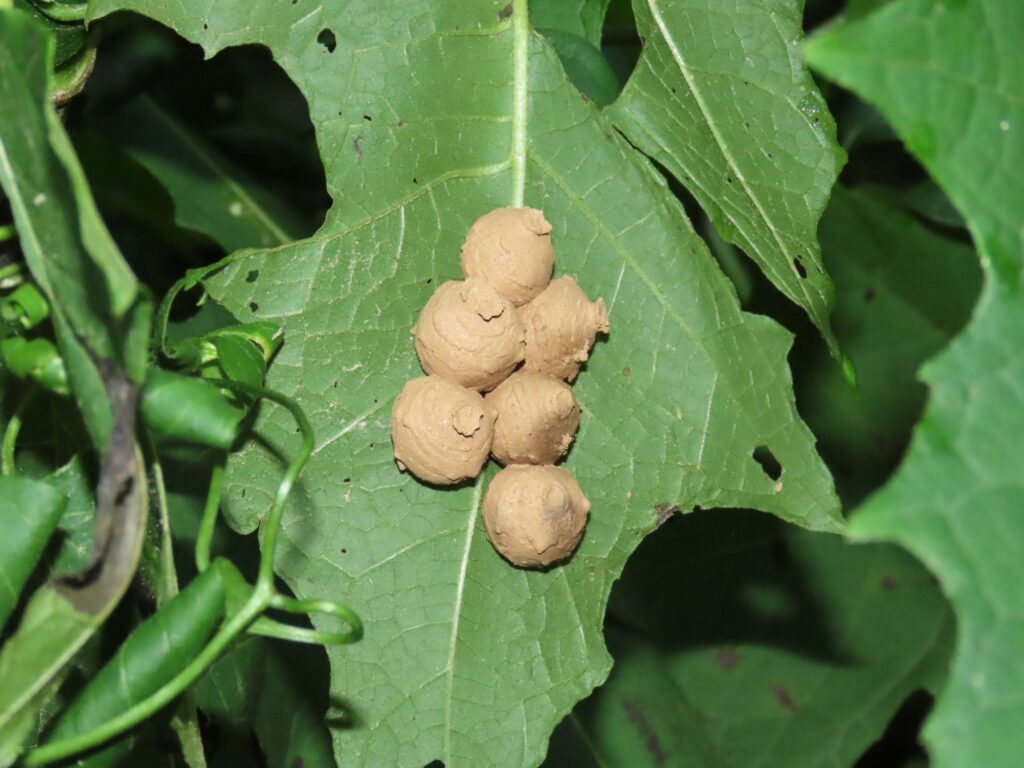
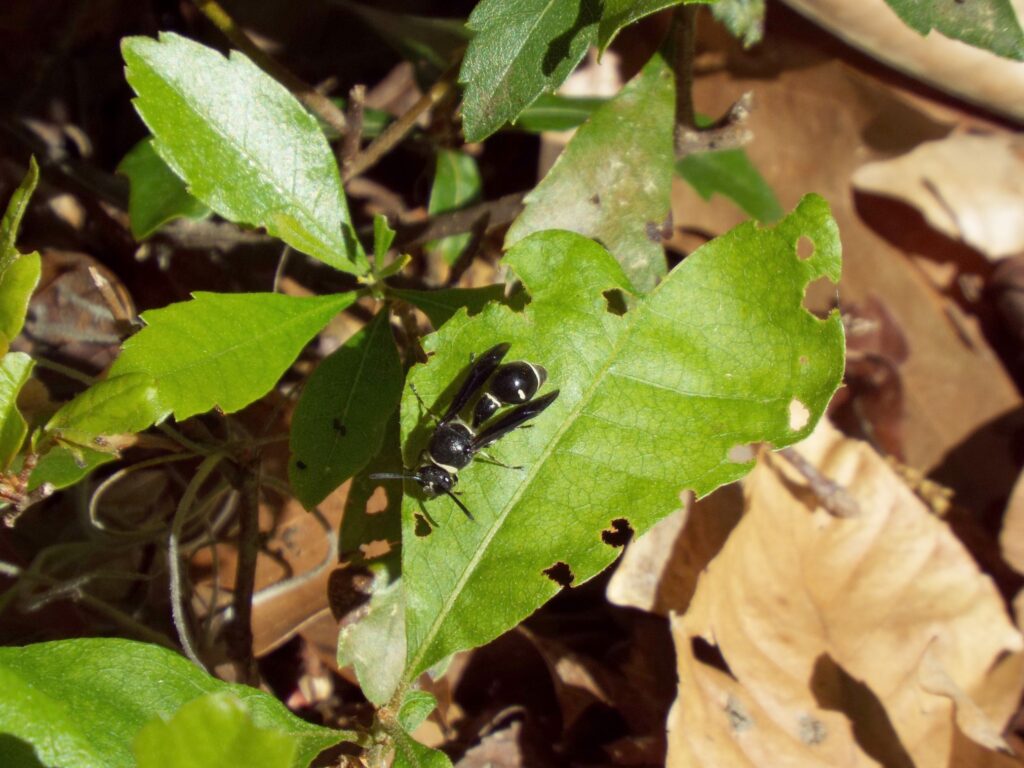
Potter Wasps, on the other hand, build free-standing nests. These nests are spherical and look like a crude earthenware urn, complete with a flared neck, spun on a potter’s wheel. They generally build these nests on the bottom of leaves or the shaded side of a building. They then stuff this urn full of paralyzed caterpillars before laying an egg within and sealing the top. The Fraternal Potter Wasp (Eumenes fraternus) is our prototypical Potter Wasp and widespread across the state. They’re less than an inch long with a round thorax, narrow waist, dark wings, and white markings on a black body.
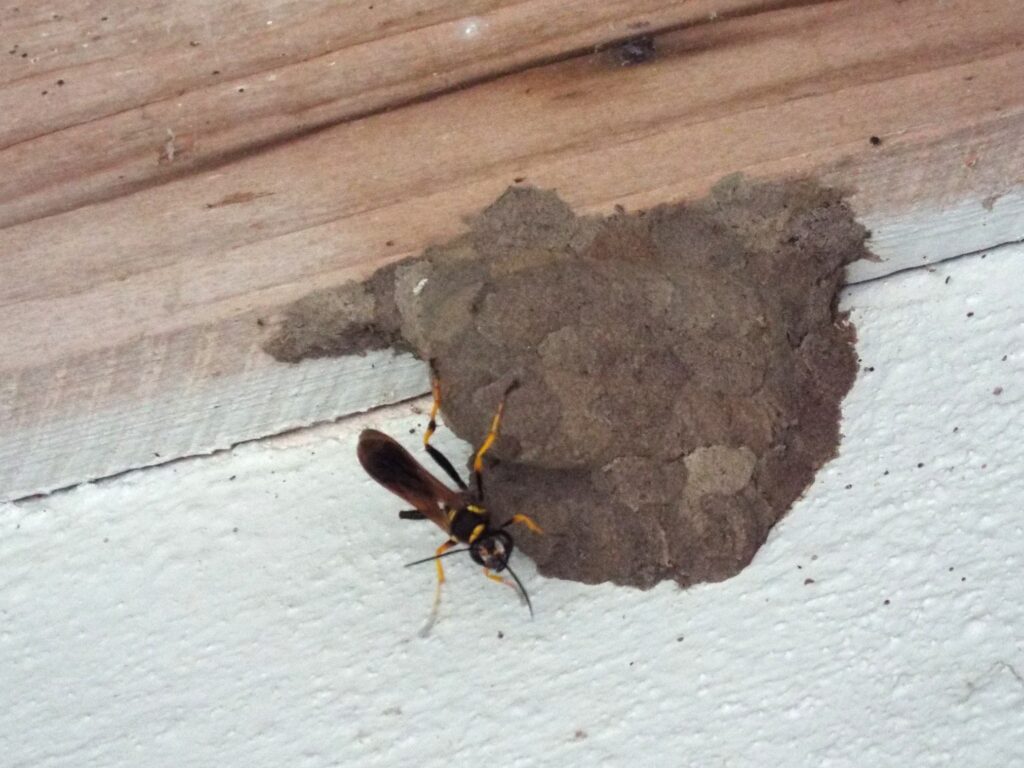
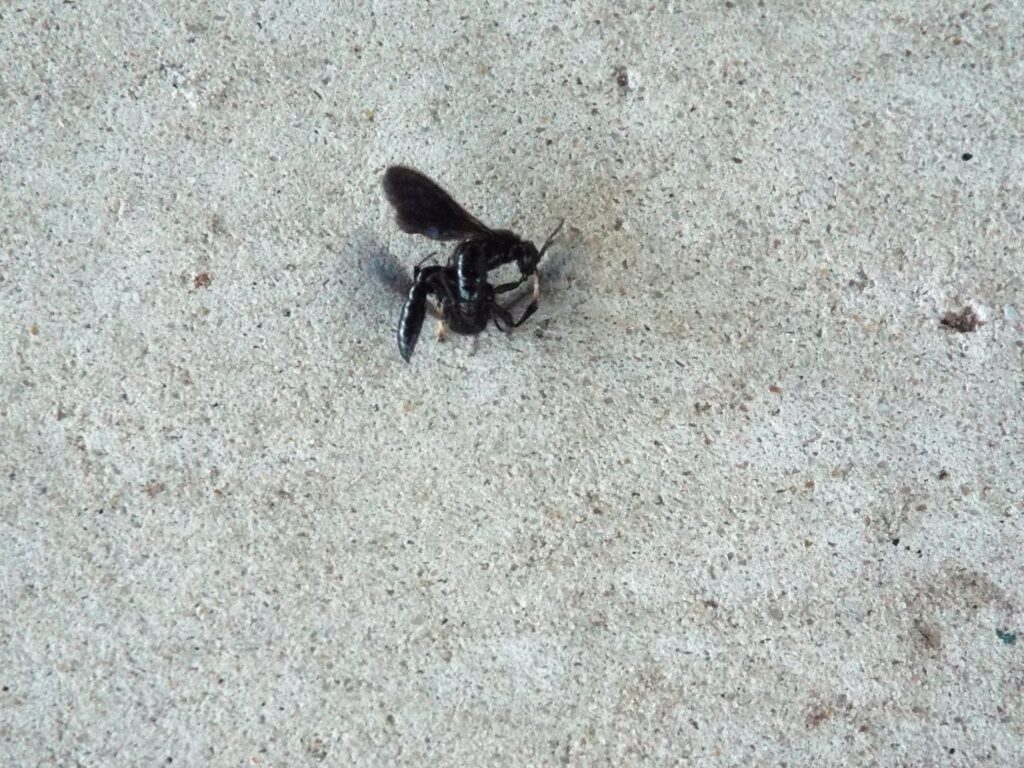

Mud-dauber Wasps also build free-standing nests but they adhere them to the side of vertical structures, like trees, rocks, and buildings. They also build large compound nests, generally with dozens of chambers. They daub mud slowly into a complex structure, just like how wattle and daub was used to build primitive houses. Mud-daubers stuff their nests full of spiders they’ve stung and paralyzed. I’ll highlight three common Mud-dauber Wasp species found throughout the state, each about an inch to inch-and-a-half in length. The Common Blue Mud-dauber (Chalybion californicum) has a metallic dark blue-green body and iridescent blue-black wings. They build disorganized mound-like nests, often with a lumpy, patchwork appearance. The Yellow-legged Mud-dauber (Sceliphron caementarium) has a black body, thread-waist, lemon-yellow legs and markings, and amber colored wings. They build boxy dome-shaped nests full of stacked cigar-shaped egg chambers. Both the Common Blue and Yellow-legged Mud-daubers belong to the Sphecidae family. The third belongs to the Crabronidae family, the Organ Pipe Mud Dauber (Trypoxylon politum). The Organ Pipe Mud-dauber is solid black, except for its iridescent blue-black wings and pale hind feet. They build rows of long tubular nests, all parallel to one another and each containing multiple chambers stacked on top of each other. These tubular nests resemble the array of pipes in a pipe organ.
Mason Wasps and Mud-daubers can both be a nuisance in their own right. (Potter Wasps not too much.) Mason Wasps love to build nests in vent tubes, drain lines, and bolt holes. Driving untold number of mechanics and technicians to madness. Organ Pipe and Common Blue Mud-dauber nests built on the side of houses can be an eyesore to many and are a pain to clean off of stucco. Yellow-legged Mud-daubers cause the same issues but they also have a special proclivity for ceiling fans and engine bays where they unbalance things that are supposed to be balanced and stuff dirt into things where dirt should not be stuffed. However, despite the nuisance and the several concussions I’ve nearly sustained from a Mud-dauber nest dislodging from a radiator fan at 3,000rpm, these Wasps play a critical role in our local ecosystems and provide several invaluable ecosystem services. First, these wasps drink nectar as adults and are stellar pollinators. Wasps are second only to bees in South Carolina in terms of pollination volume. Second, they hunt other insects. Potter and Mason Wasps generally hunt caterpillars. Moth caterpillars eat plants, for the most part, and are prone to large population swings. A ballooning caterpillar population can have radical impacts to its host plant’s population and can upset an ecosystem. Birds and reptiles can take advantage of these population swings, but they can’t grow their populations fast enough to control them. Yet, wasps can. So Potter and Mason Wasps play a critical role in controlling moth populations and stabilizing ecosystems. The same can be said for how Mud-daubers hunt spiders. Spiders eat a lot of pollinators and so they keep pollinator populations in balance. Mud-daubers in turn hunt the spiders, keeping spider populations in check and ensuring most pollinators can carry on their business as usual. Lastly, Potter Wasps and Mud-daubers make research easy for many entomologists. If an entomologist wants to study the local spider or moth populations, they can often just go find a fresh Mud-dauber of Potter Wasp nest, pop it off the wall, and crack it open in the lab like a creepy-crawly filled Kinder Egg. The arachnids and insects within the nest are alive but paralyzed by venom and are usually perfectly preserved specimens for study. This technique provides a wholly unique sampling method from anything researchers can replicate manually and has aided in the study of an untold number of arthropods!


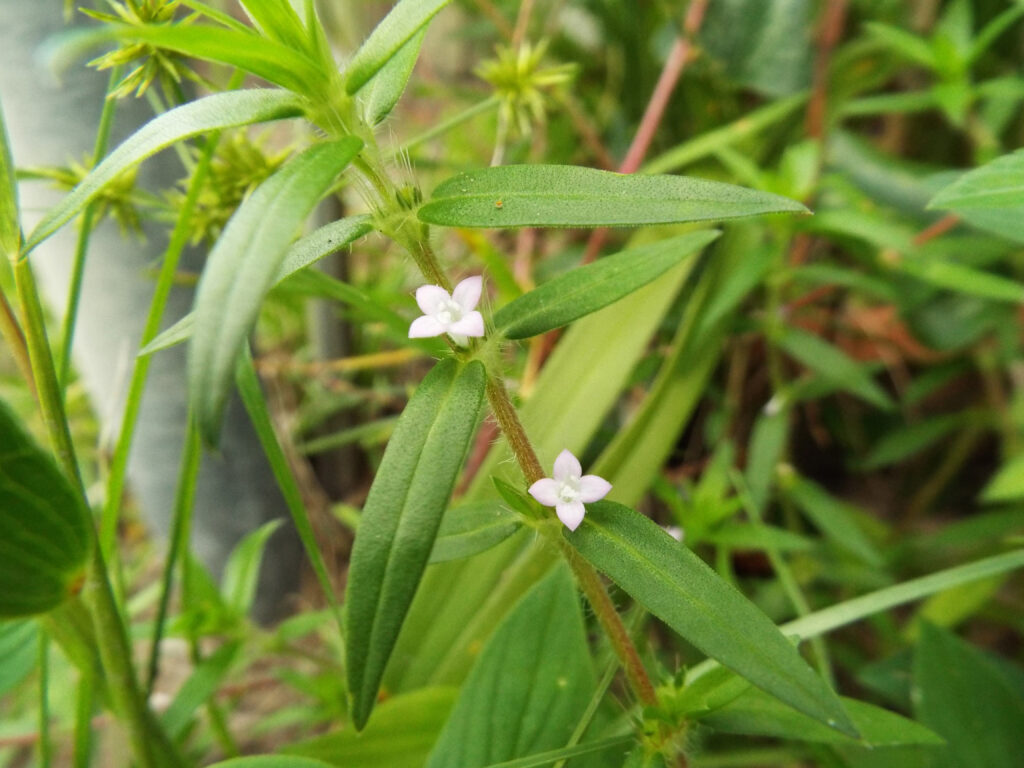
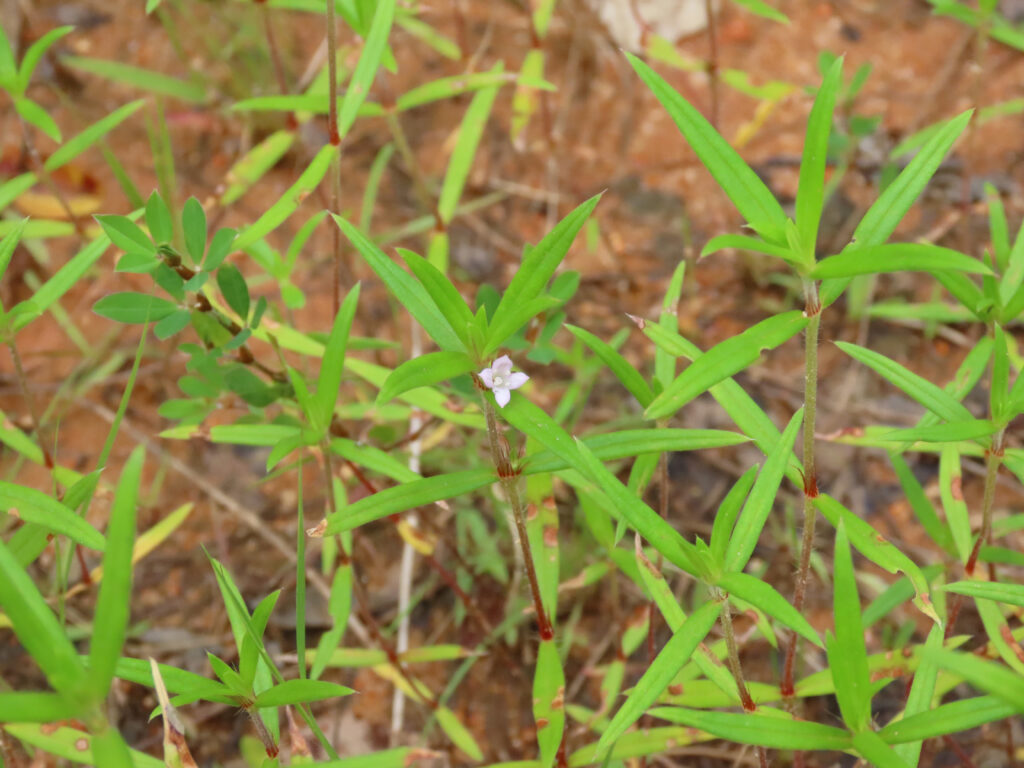
This week for Flora and Fauna Friday, we have an upland weed that fills a pollinator need, Poor-joe (Hexasepalum teres).
Poor-joe, also called Rough Buttonweed, is found on high, dry, upland soils all across South Carolina. It does best where little else grows, even on parched sands and gravel roads. Poor-joe is what’s called a pioneer plant, a species that is the first to re-colonize a heavily disturbed ecosystem. It grows in all manner of dry and sunny habitats, from eroded mountainsides in the Appalachian foothills, over top the Sandhills in the midlands, down to the sand dunes of our coastal barrier islands, and on every similar site in-between. Poor-joe usually grows about six inches high before branching and falling back down onto the ground around it. It repeats this patter and grows like this across the sand into a loose, limp bush or groundcover a foot or two across. Poor-joe’s leaves are held opposite and are narrow with a pointed tip and a prominent fold down the center. Its stems are sparsely hairy and usually a prominent burgundy color. It blooms in summer, peaking in August and September, and bearing a single flower at a time on each stem node. The flowers of Poor-joe are tiny and pastel-pink with four-pointed petals and white anthers. Although not particularly showy and despite their small size, Poor-joe is a great pollinator plant. Its flowers are often frequented by native bees and small butterflies where it provides a reliable source of life-giving nectar on the hottest of days in even the most barren of landscapes.
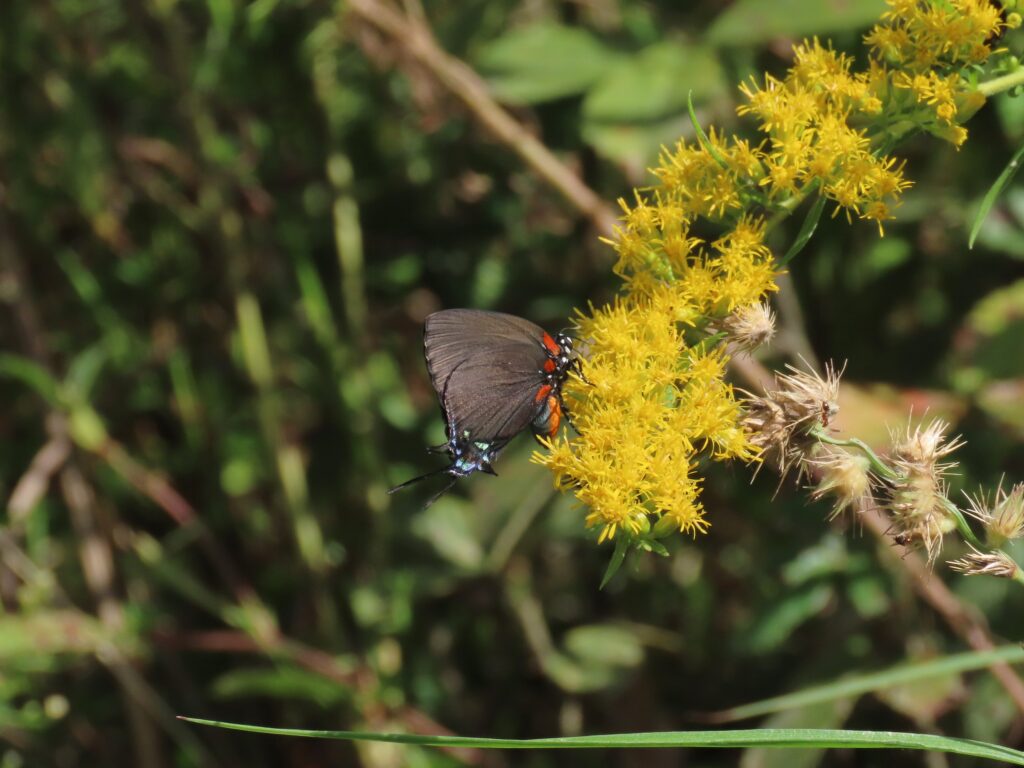
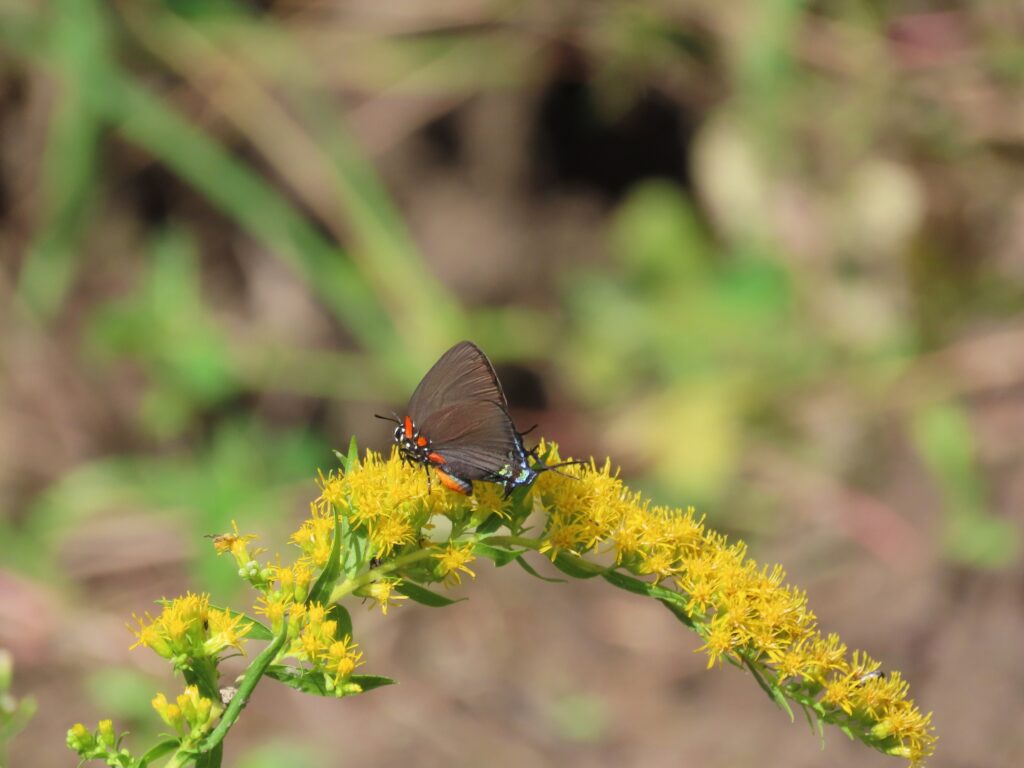


Our biggest, boldest, and most “beautimous” Gossamer-Wing butterfly, the Great Purple Hairstreak (Atlides halesus).
The Great Purple Hairstreak is an interesting member of the Hairstreak subfamily, Theclinae, and a butterfly that’s just as stunning to look at as it is scarce to see. Despite the name, Great Purple Hairstreaks are not purple, at least not in a clearly obvious way. The wing undersides for both sexes are a vaguely iridescent coal-black with burnt-orange to crimson spots at the wing bases. Their head and thorax are a deep black with scattered white spots. The abdomen is a rich orange below and a brilliant metallic sky-blue above. Both sexes boast brilliant blue colorations on both upper wing surfaces but the male has more extensive coloration of a generally darker, more sapphire-blue sheen. Males also sport a central blue patch, towards the body on the underside of the forewing, which often peaks out above the hindwing when perched. The hindwings of both sexes are tailed and studded with insets of topaz and turquoise. Some females have an additional flourish near the tails in the form of an extra burst of orange. The Great Purple Hairstreak is an unmistakable butterfly, not just because of the brilliant, one-of-a-kind coloration, but also because they’re the largest Hairstreak in North America.
Despite the bright, contrasting colors and considerable heft for a Hairstreak, this species is not often seen. The Great Purple Hairstreak is not so much rare as it is hard to find. Part of that is due to their host plant, Oak Mistletoe (Phoradendron leucarpum). Oak Mistletoe is a parasitic shrub that grows in the canopies of oak trees by tapping into the tree’s vasculature to siphon off water and nutrients. If you look up into the crown of an oak tree in winter and see a big green ball of foliage in the middle of the tree, that’s Mistletoe. Given this fact, Great Purple Hairstreaks spend much of their lives in the treetops, both while caterpillars and pupae and again as adults when searching for mates or laying eggs. So it’s harder to chance upon one than other butterflies. The first brood’s flight time peaks around the end of March and a second flush flies from late July into October. They’re most common along the edges of moist hardwood forests and usually encountered nectaring in edge habitat and gardens. They’re not a skittish butterfly by any means and, when they descend from on high to mingle among us, they’ll often let you get good up close looks at them.
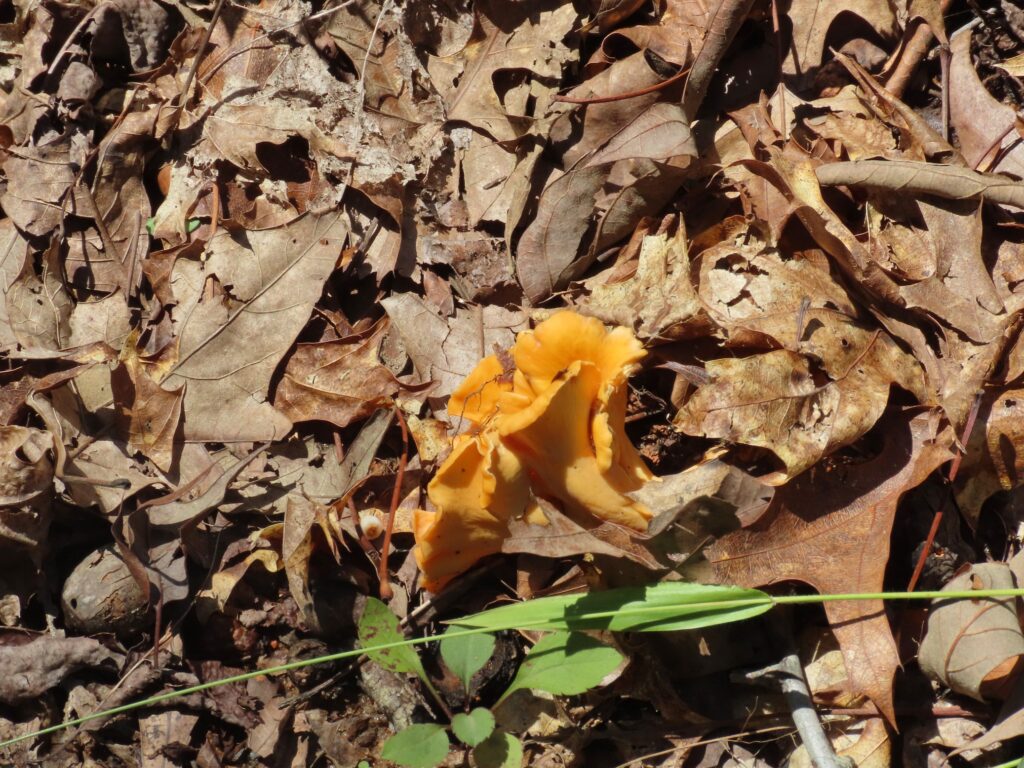
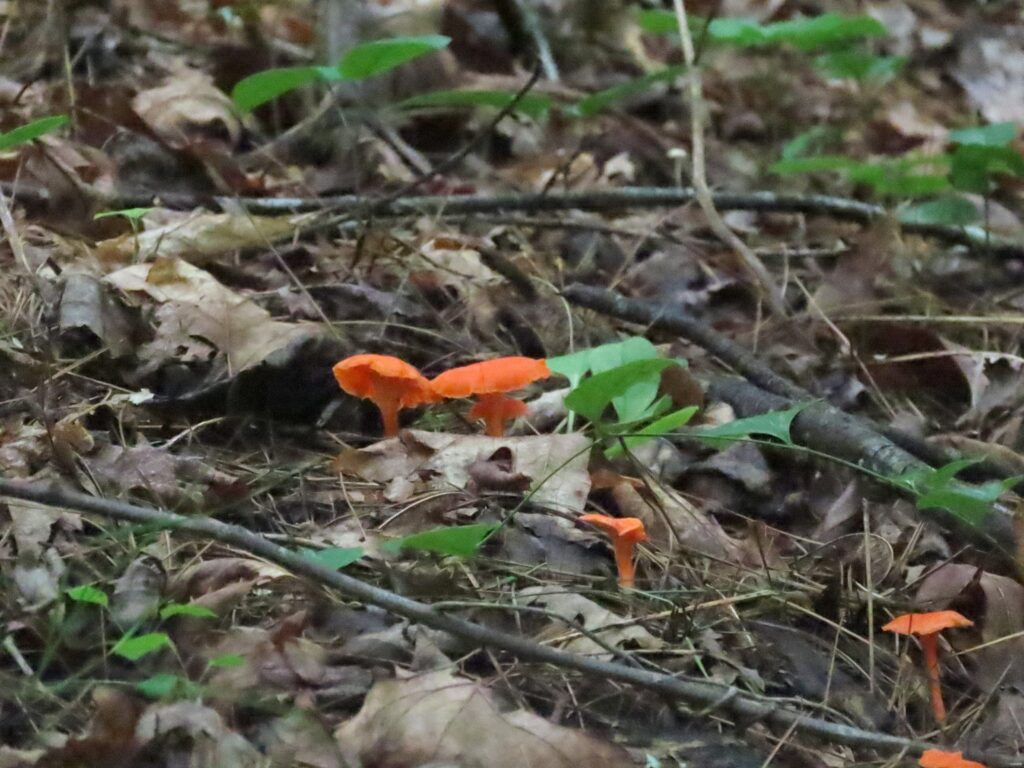
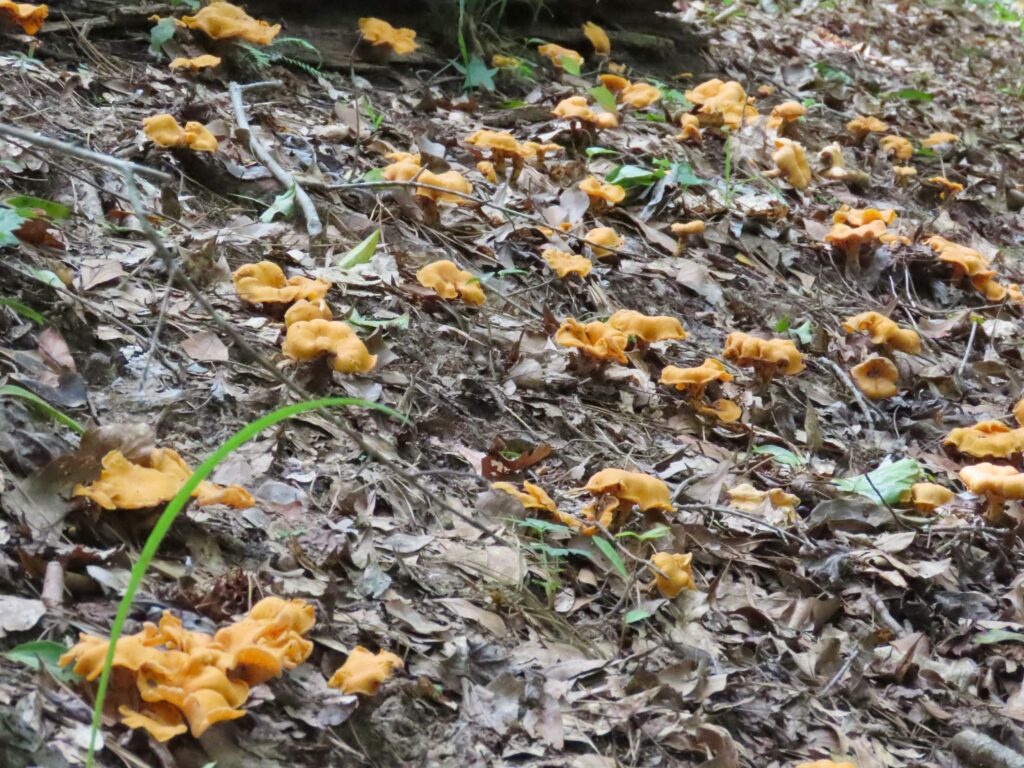
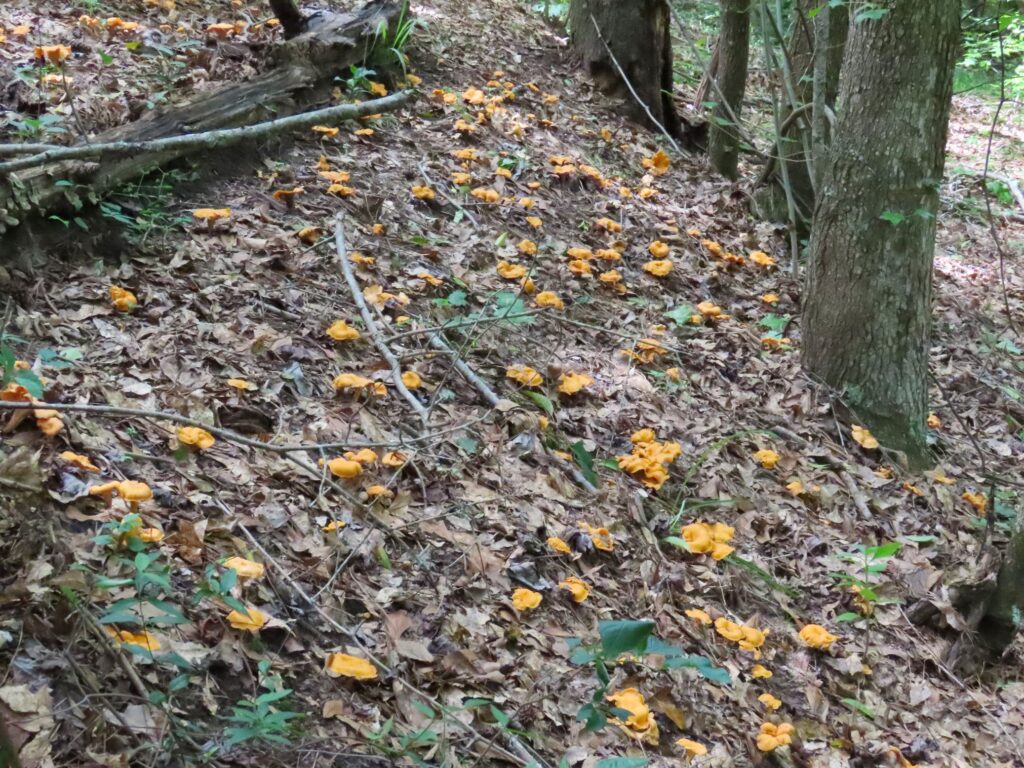
This week for Flora and Fauna Friday we have one of our most widespread and easily identifiable edible mushrooms, the Chanterelles (Cantharellus spp.).
Here in the Lowcountry we have two common species of Chanterelle, the Red Chanterelle (C. cinnabarinus) and the Smooth Chanterelle (C. lateritius) and about a half-dozen more uncommon species around the state, to include the Golden Chanterelle (C. cibarius). Chanterelles in general are yellow and orange in color, have a funnel shape with irregular, wavy margins when mature, a smooth, but not shiny, upper surface, and fleshy vein-like false-gills underneath. The Red Chanterelle is a deep orange-red in color with deep false-gills and a fairly delicate shape. The Smooth Chanterelle has a pale to rich yolk-yellow color and distinctly shallow false-gills, which slowly melt away as the cap transitions into the stalk. It has a fairly robust build and can grow a palm-sized cap, often with a highly irregular, wavy margin.
Chanterelles fruit in summer, usually peaking in August and September on Edisto Island, but the annual timing can vary based on that year’s weather. Smooth Chanterelle is by far the most common species you’ll find on Edisto Island and around the Lowcountry. I often find Smooth Chanterelles growing beneath Live Oaks in open forests and old lawns. Chanterelles are mycorrhizal fungi. This means that they survive by forming a mutualistic relationship with plants and by breaking down decaying organic matter in the soil. The plant feeds the fungus sugars and in exchange the fungus supplies the plant with nutrients it extracts from the soil. Chanterelles mainly associate with oak trees, and some other hardwood species, and breakdown decaying plant matter to extract the mineral nutrients those oak trees crave. This means you’ll never find Chanterelle mushrooms emerging out of a log or stump or springing up out in an open field with no trees around. You’ll only ever find them beneath, or nearby, hardwood trees. It’s also why Chanterelles, Morels, and Truffles are not practical to cultivate commercially, unlike the common culinary staples of Portobello, Shiitake, and Oyster mushrooms that are saprophytic and only need rotting wood to survive, rather than a whole tree to feed them.
All members of the Chanterelle genus are edible and are a highly sought after seasonal delicacy by folks who like foraging in the forest. The Golden and Red Chanterelles are considered the most flavorful of our local species, with the Smooth being similar in taste but less flavorful. However, there is a toxic imposter, the False Chanterelle (Hygrophoropsis aurantiaca), that lurks within its range. Although not deadly, you don’t want to eat it. It is pretty easy to pick out from our locally common Red and Smooth Chanterelles, given that it is neither red nor smooth, and it is also a saprophyte, often sprouting from rotten logs, but it does look very similar to other common species of Chanterelle found across the country. So if you’re thinking about foraging for fungi, please consult a reputable field guide before you start picking mushrooms.
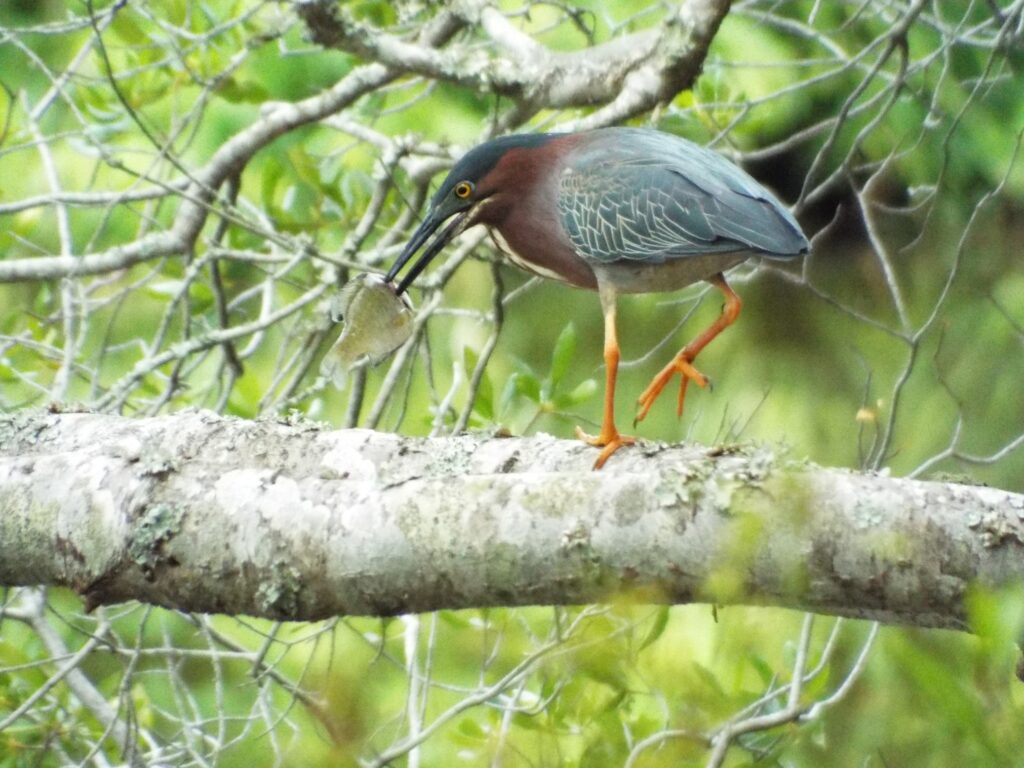
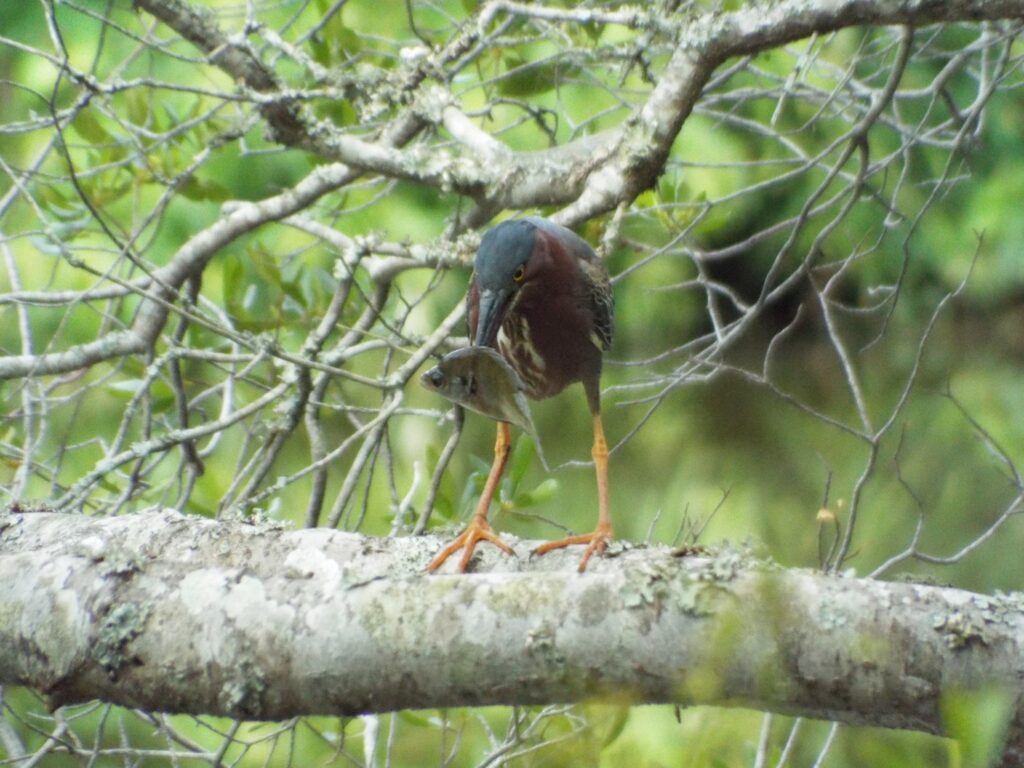


This week for Flora and Fauna Friday, we have our common compact wader, the Green Heron (Butorides virescens).
Buried between the buckling branches and broken boughs on the banks of a backwater bottomland stalks our Green Heron. Green Herons are a small, stocky wading bird with proportionately shorter legs than most of our other herons and egrets and a neck tucked tight against the body. They’re about the size of a crow. Despite the compact body plan, the Green Heron still sports that trademark long serpentine neck of the herons. Which, fully extended, is as long as its whole torso. Green Herons are an easy bird to identify just by their size and shape. However, their plumage is also distinct; Golden eyes, golden legs, dark bill, a neck and breast saturated with a rich burgundy-brown broken only by a jagged white streak down the center, all capped off with a mantle, wings, and crown of inky iridescent-green. The Green Heron’s call is a staple sound of the dog days of summer along our marshes, a sharp, ringing “Skyow!” that trails off as it soars overhead or a short burst of harsh growls and clucks as it jettisons itself from a creek bank.
Green Herons are most abundant on Edisto Island in the summer, after they’ve returned from a spring of nesting in the rookeries. However, juveniles and a few resident birds can be spotted around the Sea Islands year-round. Green Herons are generalists and can be found in most permanent wetland habitats. From the backwater lagoons of the barriers island, up the pluff-mud banks and into the cordgrass along the tidal creeks, along the rice field dikes, into the cypress swamps and bottomlands, and around the oxbow lakes, canals, reservoirs, and ponds, they can be found all across South Carolina. Green Herons are ambush hunters. They prefer to nestle onto a promising cove, snag, mat, or hummock positioned over standing water to wait for passing prey, rather than to wade for prey like our larger herons and egrets. From there they use their extra-long neck to strike through the surface of the water. Green Herons feed mainly on small fish but also a wide variety of little critters, including crayfish, insects, and frogs.
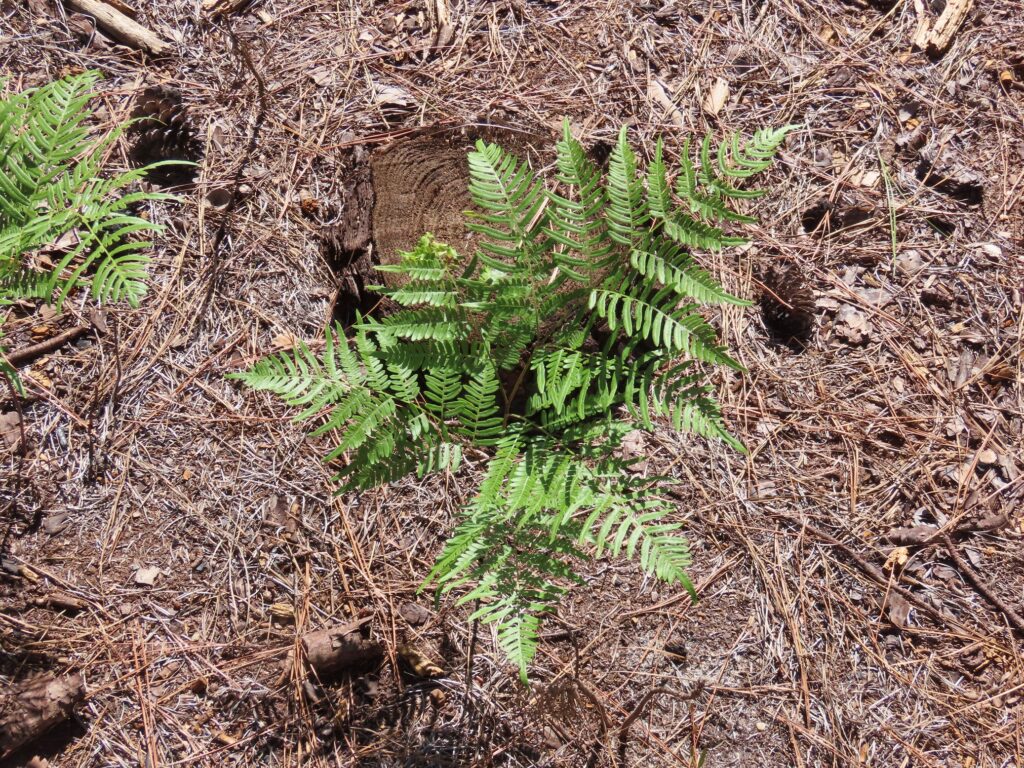

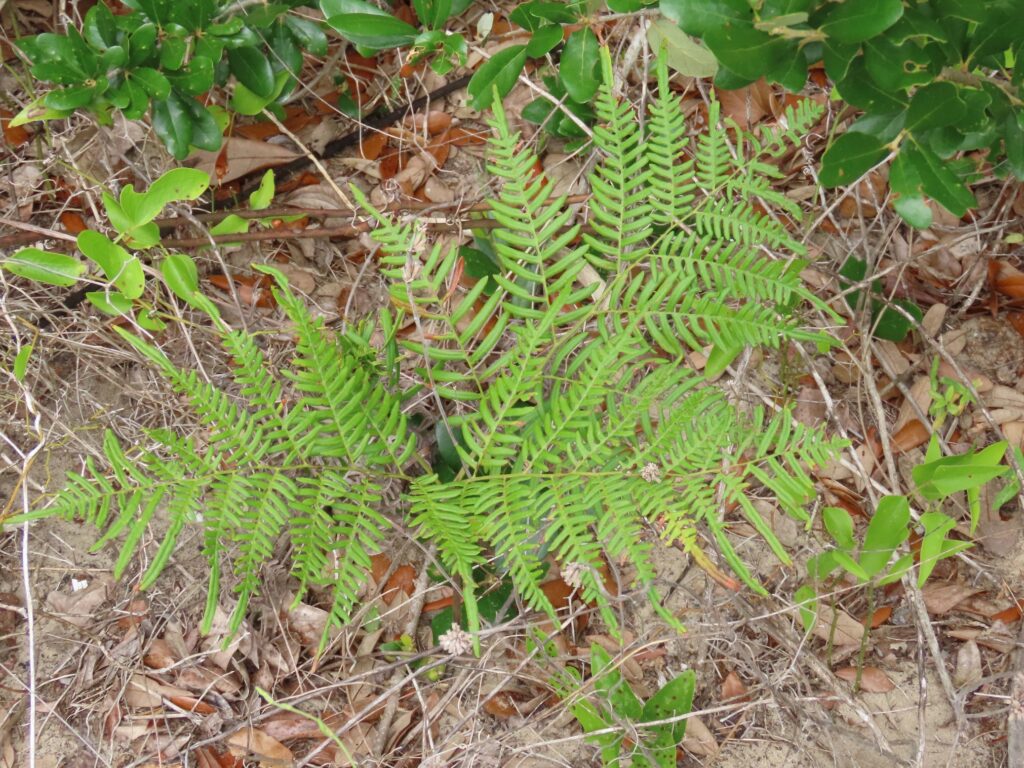
This week for flora and fauna Friday we have a common cosmopolitan colony fern, Bracken (Pteridium aquilinum).
Bracken, also called Eagle Fern, is a widespread fern in the southeast and an extremely successful genus with a worldwide distribution. Its spores are very lightweight and so it has been able to distribute itself globally through wind dispersal. Bracken generally grows in woodlands, beneath the forest canopy. It prefers more acidic soils and is both drought and fire tolerant. Thus it can be found at home practically everywhere in the Southeast. It is a vigorous colonizer and will spread laterally to form huge colonies of densely packed fronds. The fronds of Bracken are large, triangular, and often wider than they are long. They are also generally held upright, with the blade bending at a forty-five degree angle from the stalk. Each frond emerges as a single wiry stalk sent up from the earth and its leaf blade is usually divided into seven leaflets, or pinna to be technical. Each pinna is again divided into a dozen or two pinnules, which themselves each have another dozen or so lobes on them. The key things to look for to identify Bracken are these pinnules and how the lobes of those closer to the tip of the pinna start to merge together, with the terminal pinnules being narrow and un-lobed. This characteristic, along with the broad triangular frond, make Bracken easy to pick out in the southern woodlands.
Another major reason for Bracken’s success is that its foliage contains a chemical called Ptaquiloside, which is toxic to nearly all mammals. This chemical causes hemorrhagic diseases and tumors in cattle, deer, pig, rabbits, rodents, and other mammals. It is also a carcinogen in humans and can cause gastro-intestinal cancer when eaten. This means that, although Bracken can be found nearly everywhere, it is rarely eaten by herbivores and can thus grow in peace, un-browsed.
Here on Edisto Island and across the Lowcountry, Bracken is often used as an indicator species for quickly delineating wetland boundaries. Bracken is one of our few colony forming upland ferns and it grows almost exclusively on upland soils. Because of this and its ubiquitous presence on the landscape, it can serve as a rough boundary of wetlands for ecologists and land managers. Bracken will often grow right up to the edge of a permanent wetland or into the margin of regular ephemeral wetlands, but not into it. Within the wetland can be found many of our other common colony forming ferns, like Chain Ferns (Woodwardia sp.). This creates a sort of no-ferns-land on the boundary which neither the wetland ferns nor Bracken can successfully colonize. On dry years Bracken gain grounds in this boundary but then retreats inland in wet years. Thus it is not a perfect means of delineation but, in the field, it can give a good idea by eye of the area where a wetland’s boundary falls.

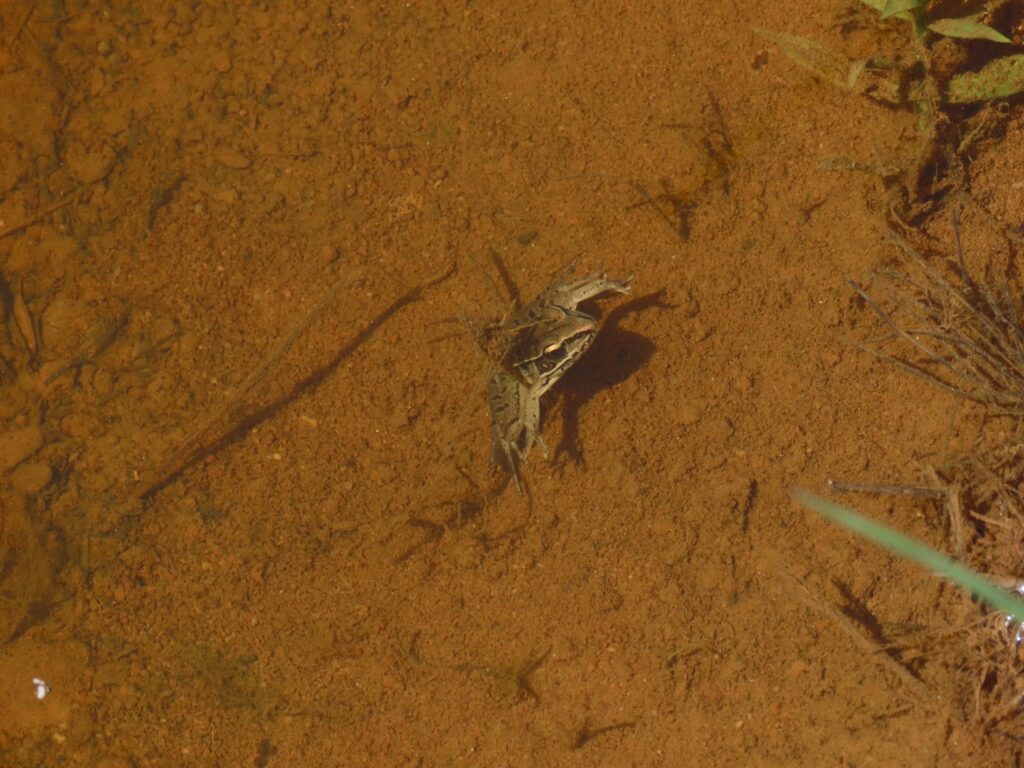
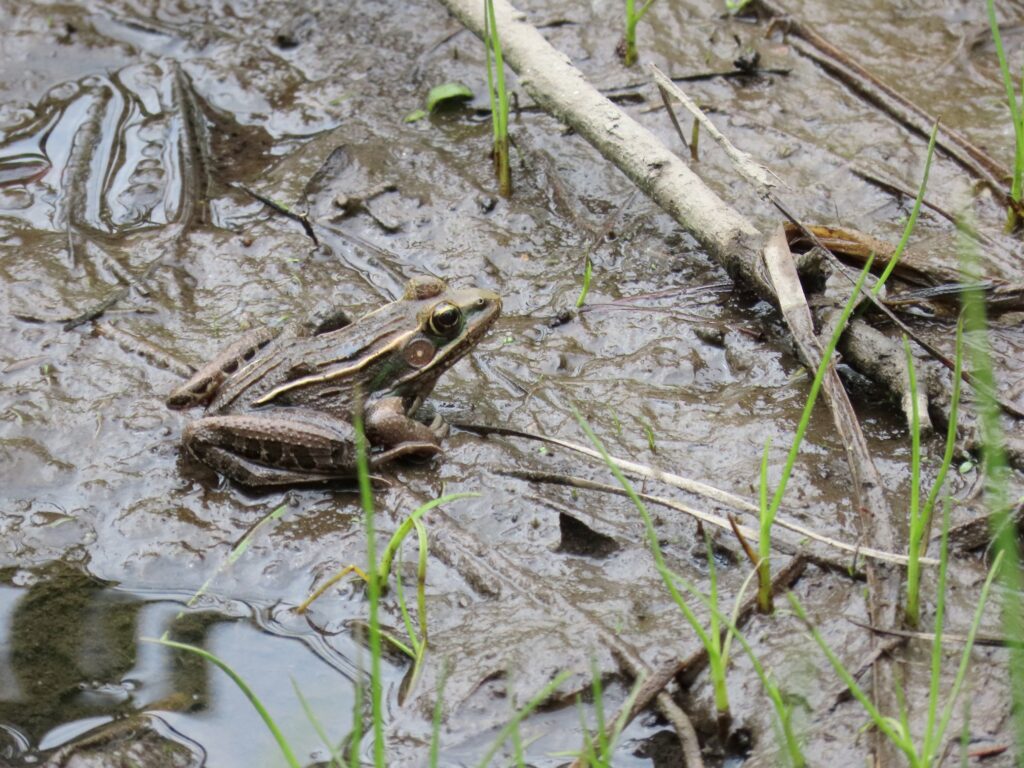

This week for Flora and Fauna Friday we’ve got a long-legged leopard-printed night-goer, the Southern Leopard Frog (Lithobates sphenocephalus).
The Southern Leopard Frog can be found all across South Carolina. They are not picky about habitat and can be found in pretty much any semi-permanent body of freshwater in the Lowcountry. They are also surprising salt tolerant for an amphibian and can even live in an array of brackish wetlands. Our Leopard Frog is the easiest to identify of the “true frogs” of the genus Lithobates. They’re roughly three inches in length and have a distinctive pointed head, with the specific epithet of their Latin name “spenocephalus” meaning “wedge-head”. Southern Leopard Frogs are primarily bronze in color and sometimes a pine-green along the spine, with two raised ivory-white lines down each side of their back and small dark-brown blotches across the body. These blotches giving it the “leopard” part of the common name. The call of our Leopard Frog is unmistakable, sounding like someone flicking the teeth on a plastic comb, except low pitched and variable in tone. Like most frogs, the best time to see and hear a Leopard Frog is at night following heavy rains. However, Leopard Frogs are also fairly active in the day and can often be spotted on pond banks and ditch edges, usually as they jump out of sight. Like most frogs, their primary defense mechanism is jumping. This allows them to shoot off the ground and move several feet in an instant, generally in the direction of the nearest body of water. Leopard Frogs primarily eat insects, spiders, worms, and other invertebrates. They usually hunt by ambush, posting up beside a wetland and allowing the prey to come to them. Frogs and Toads have a sticky tongue which they are able to flick out and whip back, drawing food into their mouth.
Leopard Frogs prefer to lay eggs in shallow ephemeral wetlands. Ephemeral wetlands are lowland areas which dry up entirely during the year. More particularly, frogs and other amphibians like to breed in isolated ephemeral wetlands. These are areas that are disconnected and distant from permanent wetlands and generally only fill with water after prolonged heavy rains. These conditions are important to the frog because it means there are no fish, which are the number one predator of their eggs and tadpoles. Non-isolated ephemeral wetlands, like floodplains and marshes, often flood when a nearby permanent wetland overflows or a stream breaches its banks. Within those floodwaters comes fish and fish eggs, which populate the ephemeral wetland and feed on the frogs and their offspring. Isolated ephemeral wetlands have less risk of fish establishing and so are often a safer bet for a baby frog nursery.


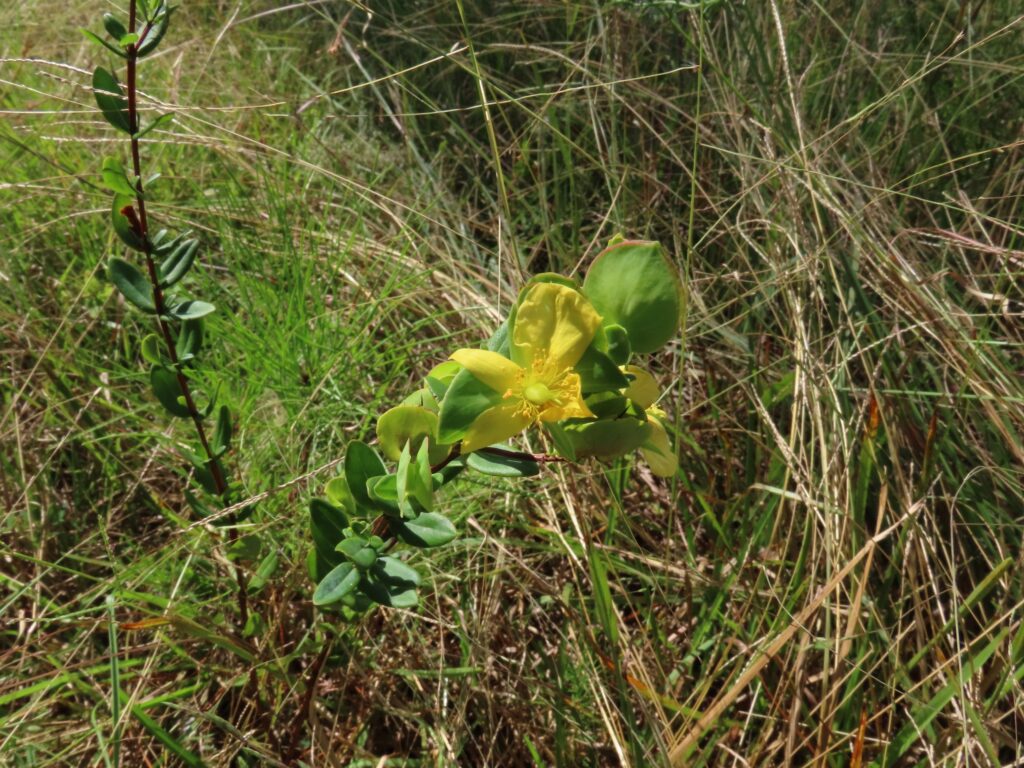
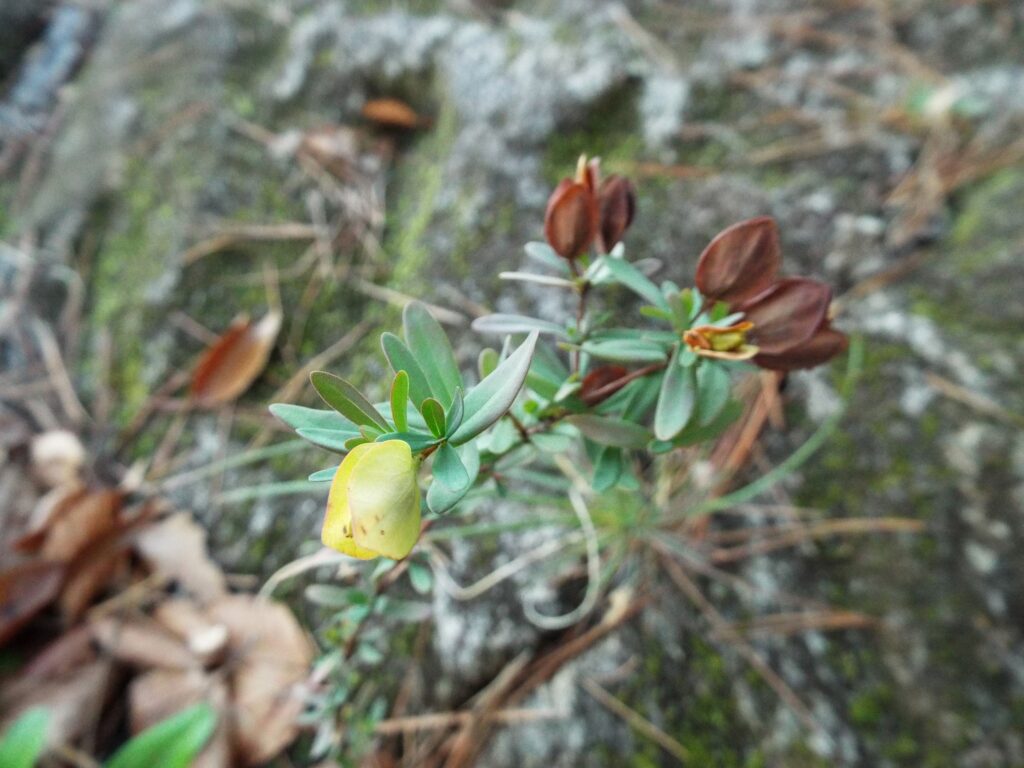
This week for Flora and Fauna Friday we have an overlooked but very common wildflower, St. Andrew’s-cross (Hypericum hypericoides).
St. Andrew’s-cross is found throughout the Southeast and South Carolina. It’s a member of the St. John’s-worts and, in my opinion, our most common and easily identified member of their genus. St. Andrew’s-cross can be found in all manner of upland habitats and is particularly common on our sandy coastal soils. St. Andrew’s-cross is a small woody shrub, often only growing one to three feet tall with sparsely vegetated branches. It’s perennial and evergreen, with opposite, simple leaves a shade of soft, pale green. Its stems are narrow and rich cinnamon-brown. St. Andrew’s-cross blooms in the dead of summer, generally starting in July and continuing through August. Its flower is light yellow with four narrow petals, laid flat atop two spade-shaped bracts, and at the center a small off-green ovary in a cloud of short anthers. Distinctly, its flower petals are set apart from each other at roughly sixty and one-hundred-and-twenty degree angles, rather than a square ninety degrees. Once pollinated, the petals fall away and the two bracts dry and fold up to enclose the ovary like a clamshell. These folded up bracts, along with the diagonal flowers, make this plant easy to identify in the field.
Today’s plant gets its common name from the uneven diagonal arrangement of its flower. This petal pattern of the St. Andrew’s-cross flower is reminiscent of the shape of St. Andrew’s Cross, the form of which is best exemplified by the saltire on the Flag of Scotland. The Apostle Andrew was said to have been crucified on a diagonal cross. The flag of Scotland prominently displays a single diagonal cross and was named in reverence of St. Andrew. The Scottish flag itself is likely the inspiration for the name of the St Andrew’s-cross plant.
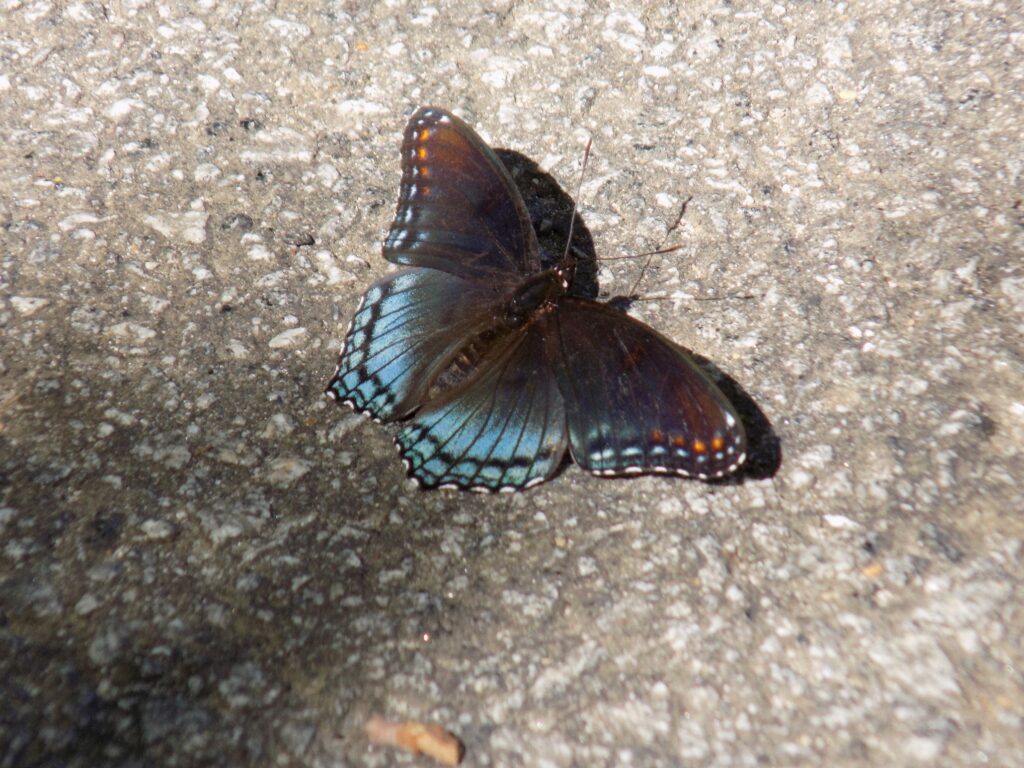
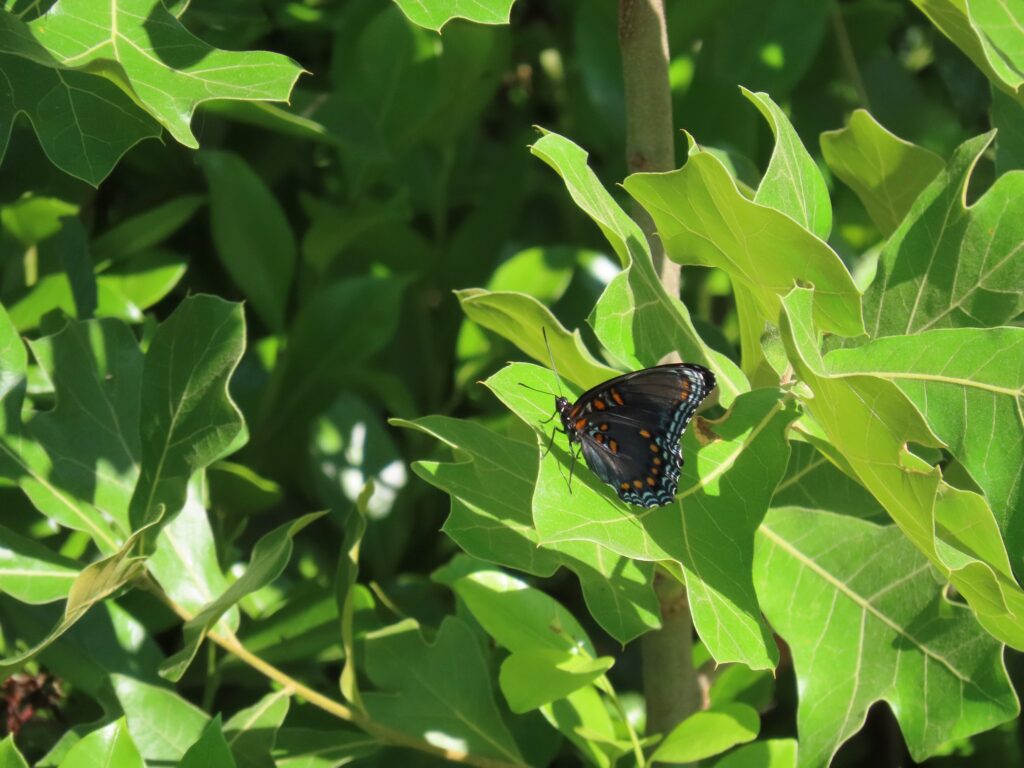

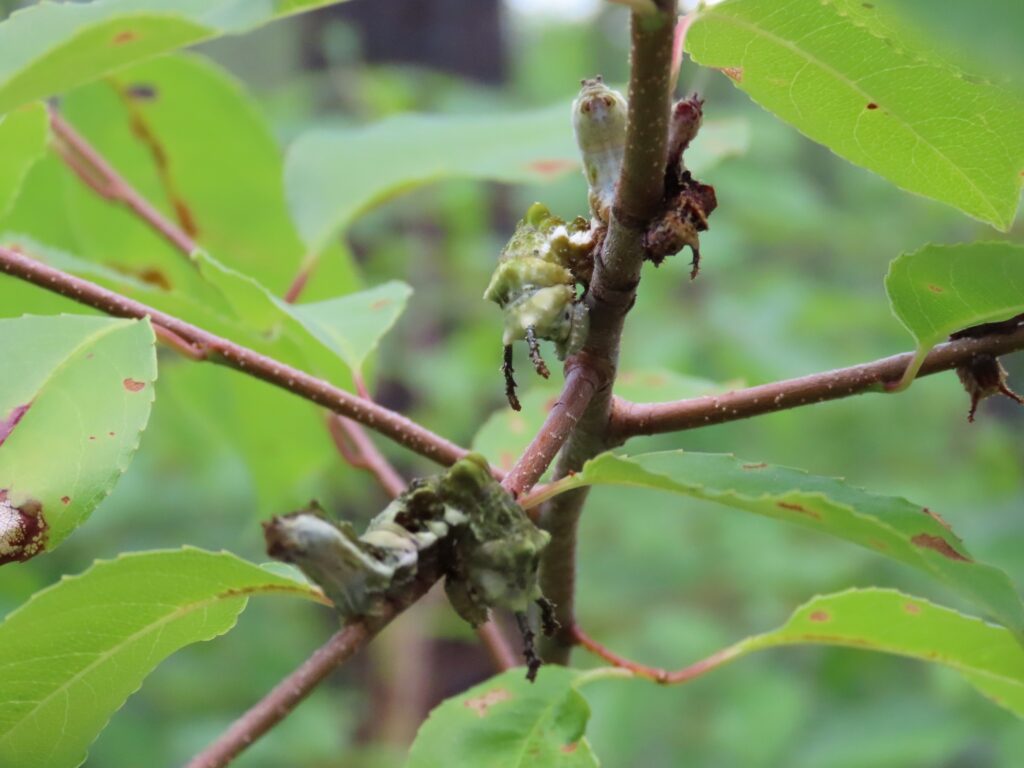
This week for Flora and Fauna Friday we’ve got a two-faced cherry-picking butterfly, the Red-spotted Purple (Limenitis arthemis astyanax).
The Red-spotted Purple is a common woodland butterfly found throughout the Eastern United States. It’s a moderately-large butterfly found along forest edges, dirt roads, walking trails, and orchards. They are partial to landing on bare ground to lap up minerals from damp soil. You’re just as likely to see them on the ground as you are on a flower, and they’re hard to miss! The Red-spotted Purple has a black base color. On the top of the wings it is washed in a vibrant sky-blue iridescence. This blue and black is complimented by fine white marks on the wing margins and a handful of orange spots at the tips of the forewing. Underneath, bold orange spots dominate the pattern, flanking the wing margins atop waves of powder-blue crescents in a sea of faint, blue iridescence. They are one of our most striking butterflies. The Red-spotted Purple’s caterpillars host on several groups of woody plants including willows, blueberries, and cherries. Black Cherry is their preference around Edisto Island. Both the larvae and pupae of Red-spotted Purples mimic bird droppings.
The Red-spotted Purple is a subspecies of the White Admiral (L. arthemis), which is found along the Great Lakes and in New England. The two subspecies have markedly different color patterns but are still all one species. The White Admiral has a heavy white band across each set of wings. This white band is totally absent in our Red-spotted Purple, instead replaced by extensive blue iridescence. The red-spotted Purple is in the same genus as the Viceroy (L. archippus) and these two species share similar body shapes, behaviors, and ecologies. One of those shared traits is mimicry. The Viceroy mimics the toxic Monarch and the Red-spotted Purple mimics the poisonous Pipevine Swallowtail. Interesting to note is that the Red-spotted Purple’s range stops and the White Admiral starts at the same latitude where the Pipevine Swallowtail’s range ends. So the mimicry clearly offers an advantage to the species in the South but must be a hindrance in the Northeast.



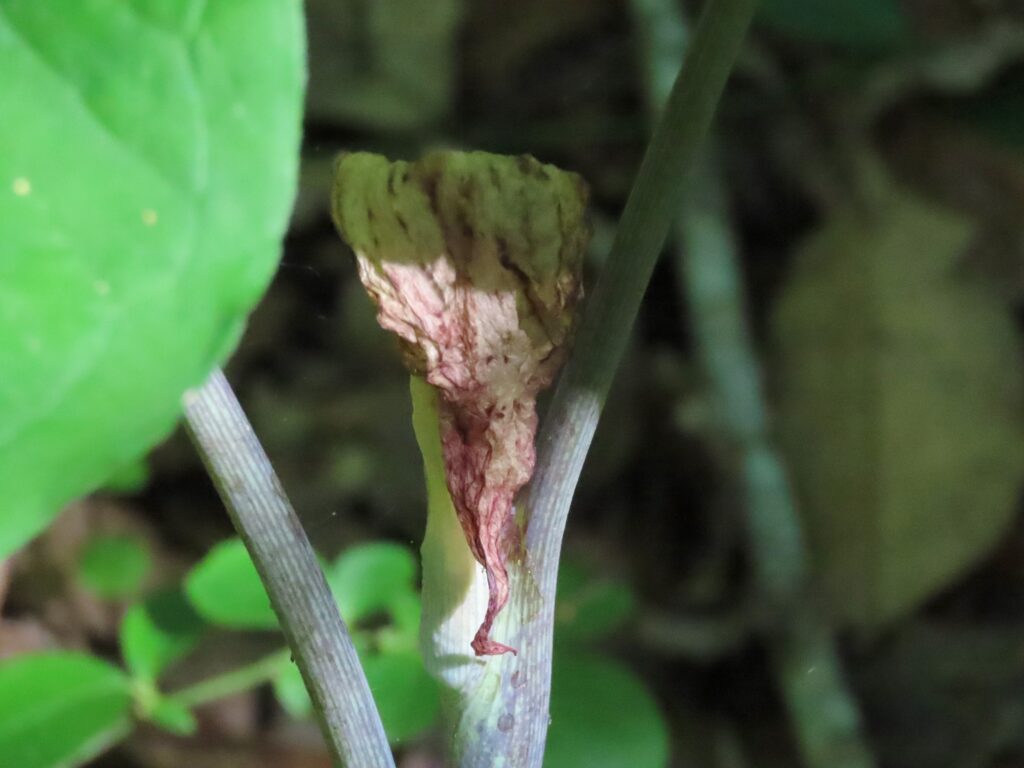
This week for Flora and Fauna Friday we have a widespread wildflower of wet woodlands, Jack-in-the-pulpit (Arisaema triphyllum).
Jack-in-the-pulpit is a perennial wildflower found throughout the Eastern United States, to include Edisto Island. It grows most commonly in shady woodlands with a sparse understory. There it crops up singly or in a small colony within depressions and damp spots in the soil with a high water table. Jack-in-the-pulpit is an easy plant to identify. It has large three-lobed leaves that emerge straight from the ground, generally in pairs, with each leaflet being angled roughly ninety degrees apart from one another and the whole leaf reaching a foot or two above the ground. Below these leaves emerges a unique flower for our uplands.
Jack-in-the-pulpit is a member of the Arum family, Araceae. Arums are best known for their large leaves and unique flowers. Arum flowers have two distinctly visible parts, an outer spathe and an inner spadix. The spadix is a spike that contains the real flowers, both male and female. The spathe is an outer covering that wraps around and protects the spadix and functions a bit like petals and sepals do on other flowers. It also acts as a funnel to channel pollinators down to the true flowers. In Jack-in-the-pulpit, the flower stands upon its own vertical stalk and is a pale green cup with longitudinal stripes. Those stripes are either a darker green or a deep burgundy. The spathe wraps the whole way around the spadix and curls down over the top to form a hood. From within the spathe the rounded tip of the spadix peeks out. This uniquely shaped flower is where the Jack-in-the-pulpit name comes from, as the bloom looks like a man (assumedly the fella’s name is Jack) peering out from an elevated gothic-style pulpit. Jack-in-the-pulpit blooms in mid-spring. Its flowers are pollinated by tiny fungus gnats. Flies are the target pollinators for most Arums. Arum flowers go so far as to emit specialized scents and their spadix even generates its own “body” heat to attract to attract flies! Jack-in-the-pulpit is no exception there. Once pollinated, the flower matures into a cylindrical cluster of bright red berries.
Lastly, Jack-in-the-pulpit is a species complex containing five separate subspecies. Each of these subspecies has discernable physical characteristics, differences in their ranges and ecologies that keep them reproductively isolated, and genetic variation. Many botanists consider them separate species while many others consider them just subspecies. However, as far as I can figure, here in the South Carolina Lowcountry we have but one of these subspecies, the traditionally named Jack-in-the-pulpit (Arisaema triphyllum).